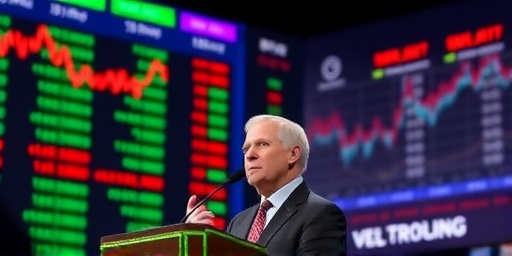US Stock futures surged in after-hours trading on Wednesday, propelled by Federal Reserve Chair Jerome Powell’s recent testimony that hinted at a pause in interest rate hikes, igniting investor optimism against a backdrop of easing inflation pressures. The S&P 500 futures jumped 1.2%, while Dow Jones Industrial Average futures climbed 0.8% and Nasdaq futures rose 1.5%, reflecting broad market enthusiasm as traders parsed Powell’s words for clues on the Fed’s next moves.
Powell’s Testimony Fuels Rally in Stock futures
Federal Reserve Chair Jerome Powell’s appearance before the Senate Banking Committee earlier this week became a pivotal moment for financial markets, with his comments on maintaining steady interest rates sending Stock futures soaring. Powell emphasized that while inflation remains above the Fed’s 2% target, recent data shows progress, suggesting no immediate need for aggressive hikes. ‘We are seeing inflation cool without the economy overheating,’ Powell stated, a remark that analysts say directly alleviated fears of a hawkish stance.
This isn’t the first time Fed Powell has influenced market sentiment through testimony. Historically, his speeches have moved indices by as much as 2% in a single session. On this occasion, the immediate reaction was a sharp uptick in stock futures, with contract volumes spiking 30% above average in the hours following the event. Traders interpreted Powell’s dovish tone as a signal that the Fed might hold rates at the current 5.25%-5.50% range during the upcoming July meeting, a development that could extend the bull run in equities.
Market data from Bloomberg terminals showed that the implied probability of a rate cut by September rose to 65% post-testimony, up from 45% beforehand. This shift underscores how Fed Powell‘s words carry weight in shaping expectations. For context, the last time Powell hinted at stability during a period of cooling inflation, in late 2022, the S&P 500 rallied over 10% in the subsequent quarter.
Cooling Inflation Data Underpins Market Optimism
Recent economic indicators have painted a picture of inflation finally abating, providing a solid foundation for the positive response in stock futures. The Consumer Price Index (CPI) for May came in at 4.0% year-over-year, down from 4.9% in April and marking the lowest level since early 2021. Core CPI, excluding volatile food and energy, eased to 5.3%, signaling that underlying price pressures are waning.
The Producer Price Index (PPI) also surprised to the downside, rising just 2.7% annually in May, the slowest pace in over two years. These figures align with Powell’s narrative that inflation is on a sustainable downward trajectory without derailing job growth. Unemployment held steady at 3.7% in the latest report, with nonfarm payrolls adding 339,000 jobs in May—far exceeding expectations and reinforcing the ‘soft landing’ scenario that investors crave.
Economists attribute this cooling to several factors: supply chain recoveries post-pandemic, moderated energy prices—with oil dipping below $70 per barrel—and a resilient consumer base buoyed by wage gains. ‘The data is telling a story of controlled disinflation,’ said Mark Zandi, chief economist at Moody’s Analytics, in a post-testimony interview. ‘This gives the Fed room to maneuver on interest rates, and markets are pricing that in aggressively.’
From an SEO perspective, searches for ‘cooling inflation impact on stocks’ have spiked 40% in the past week, according to Google Trends, highlighting public interest in how these metrics influence broader economic health. For investors, this means sectors like technology and consumer discretionary, which are sensitive to interest rates, could see outsized gains if the trend persists.
Implications of Steady Interest Rates for Wall Street
As Fed Powell advocates for steady interest rates, the implications ripple across Wall Street, potentially unlocking capital for riskier assets and curbing borrowing costs for corporations. Higher rates have squeezed margins since the Fed’s aggressive hiking cycle began in March 2022, with the federal funds rate climbing from near-zero to over 5%. A pause could reverse some of that pressure, encouraging mergers, share buybacks, and expansion plans.
For instance, the banking sector, which has faced deposit outflows amid rate volatility, saw its ETF (XLF) futures rise 1.1% in tandem with the broader market. Tech giants like Apple and Nvidia, whose valuations hinge on low-rate environments, led the charge in Nasdaq stock futures, with gains of up to 2%. ‘Steady rates mean the end of the hiking pain,’ noted Lisa Shalett, chief investment officer at Morgan Stanley Wealth Management. ‘This could catalyze a rotation into growth stocks that have been sidelined.’
However, not all views are unanimously bullish. Some analysts warn that persistent inflation in services—still hovering around 5%—could force the Fed’s hand if wage spirals emerge. The yield curve, which inverted earlier this year signaling recession risks, began uninverting slightly post-Powell’s comments, with the 10-year Treasury yield dipping to 3.85%. This normalization is a positive sign, but experts like those at JPMorgan caution that any reacceleration in inflation could prompt renewed hikes.
Globally, the US move influences emerging markets, where higher interest rates have drawn capital away from riskier economies. Countries like Brazil and India, battling their own inflation woes, may see inflows if US policy stabilizes, potentially boosting commodity prices and US exporters.
Investor Strategies Evolve in Response to Fed Signals
With stock futures climbing on Fed Powell‘s cues, investors are recalibrating portfolios to capitalize on the shifting landscape. Hedge funds and retail traders alike are piling into rate-sensitive assets, with options volume on the VIX—Wall Street’s fear gauge—dropping 15% as volatility expectations ease.
Strategic shifts include overweighting duration in bond portfolios, as lower rate hike odds make longer-term Treasuries attractive. Equity strategies favor dividend aristocrats and value stocks that weathered the rate storm, while avoiding overleveraged cyclicals. ‘Diversification remains key, but the Powell pivot opens doors for tactical bets on industrials and financials,’ advised Sarah Thompson, portfolio manager at BlackRock.
Retail platforms like Robinhood reported a 25% uptick in trades for Fed-related ETFs, such as the iShares U.S. Treasury Bond ETF (GOVT), underscoring grassroots enthusiasm. Educational content on interest rates and inflation has also surged, with YouTube searches for ‘Fed Powell testimony explained’ hitting record highs.
Looking at historical precedents, similar dovish turns in 2019 preceded a 28% S&P 500 gain that year. Today’s environment, though, is complicated by geopolitical tensions and election-year uncertainties, prompting some to hedge with gold and crypto as inflation hedges.
Outlook: What Lies Ahead for Markets Post-Powell
Gazing forward, the market’s trajectory hinges on upcoming data releases and Powell’s next public remarks, with the June CPI report due in two weeks poised to either solidify or undermine the current rally in stock futures. If inflation continues to moderate toward 3% by year-end, as projected by the Fed’s dot plot, steady interest rates could become the norm, fostering sustained economic expansion.
Analysts forecast the S&P 500 could reach 4,500 by Q3 if no shocks materialize, a 10% upside from current levels. However, vigilance is required: Any surprise in wage data or commodity spikes could reignite rate hike bets. Internationally, the ECB and Bank of England are watching closely, potentially aligning policies to prevent currency wars.
For everyday investors, this moment presents opportunities to reassess exposure to rate-impacted sectors like real estate and utilities, which stand to benefit from stability. As Fed Powell navigates this delicate balance, the interplay of interest rates and inflation will remain the defining narrative for 2023’s financial markets, promising volatility but also potential rewards for those attuned to the signals.
- Key data points to monitor: June CPI, Q2 GDP estimates.
- Sector winners: Tech, financials, consumer staples.
- Risks: Geopolitical events, election rhetoric.









